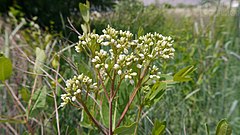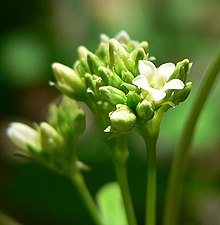Apocynum cannabinum
| Apocynum cannabinum | |
|---|---|

| |
| Apocynum cannabinum in flower | |
| Scientific classification | |
| Kingdom: | Plantae |
| Clade: | Tracheophytes |
| Clade: | Angiosperms |
| Clade: | Eudicots |
| Clade: | Asterids |
| Order: | Gentianales |
| Family: | Apocynaceae |
| Genus: | Apocynum |
| Species: | A. cannabinum
|
| Binomial name | |
| Apocynum cannabinum | |

| |
| Natural range in North America[2] | |
| Synonyms[3] | |
| |
Apocynum cannabinum (dogbane, amy root, hemp dogbane, prairie dogbane, Indian hemp, rheumatism root, or wild cotton)[4] is a perennial herbaceous plant that grows throughout much of North America—in the southern half of Canada and throughout the United States. It is poisonous to humans, dogs, cats, and horses. All parts of the plant are toxic and can cause cardiac arrest if ingested. Some Lepidoptera feed on this plant, such as the hummingbird moth.
Description
[edit]Apocynum cannabinum grows up to 1 m (3 ft 3 in) tall. The stems are reddish and contain a milky latex. The leaves are opposite, simple broad lanceolate, 7–15 cm (2+3⁄4–6 in) long and 3–5 cm (1+1⁄4–2 in) broad, entire, and smooth on top with white hairs on the underside. It flowers from July to August, has large sepals, and a five-lobed white corolla. The flowers are hermaphrodite, with both male and female organs.[5]

Taxonomy
[edit]Etymology
[edit]Apocynum means "poisonous to dogs".[citation needed] The specific epithet cannabinum, and the common names hemp dogbane and Indian hemp refer to its similarity to Cannabis as a source of fiber.[6] It likely got its name from its resemblance to a European species of the same name.[which?][7] It is called qéemu [qǽːmu] in Nez Perce[8] and [taxʷɨ́s] in Sahaptin.[citation needed] The Maidu Concow people call the plant pö (Konkow language).[9]
Distribution and habitat
[edit]Apocynum cannabinum grows in open wooded areas, ditches, and hillsides. It is found in gravelly or sandy soil, mainly near streams in shady or moist places.[5] It is native to much of North America—in the southern half of Canada and throughout the United States.[2]
Ecology
[edit]
The plant serves as a larval host for the snowberry clearwing (Hemaris diffinis),[10] which is a pollinator that resembles a small hummingbird.[11] It is also a host plant for the dogbane tiger moth (Cycnia tenera) and the zebra caterpillar (Melanchra picta). The larvae of Marmara apocynella[10] feed on the stems, making a "long whitish serpentine mine".[12]
Toxicity
[edit]It is poisonous to humans,[5] dogs, cats, and horses.[13] All parts of the plant are toxic, and the plant contains cardiac glycosides.[5] The plant is toxic both green and dried.[14] The stems contain a white sap capable of causing skin blisters.[15]
Uses
[edit]Fiber
[edit]Much like flax and hemp, Apocynum cannabinum contains long fibers in the stems, known as bast fibers, which can be extracted and used to create textiles. The fibers are very fine and strong, with a silky texture, and easier to process than hemp.[6] The stalks of this plant have been used as a source of fiber by Native Americans[16] to make bows, fire-bows, nets, tie down straps, hunting nets, fishing lines, bags,[17] and clothing.[7] According to Craig Bates of the Yosemite Museum, five stalks of the plant are needed to make one foot of cordage. A large bag used for storing roots would take one to three months to complete.[18] The stems should be harvested in the fall, after the leaves have fallen and the stalks have turned a deep reddish-brown color. Since cutting the stalks promotes regrowth in the spring, as much as possible should be harvested. Unused stems are traditionally cleared away by burning, which causes the plant to grow back taller and straighter in spring.
Food
[edit]The seeds have an edible use as a meal (raw or cooked) when ground into a powder.[5]
Chewing gum
[edit]The plant's latex sap can be squeezed from the plant and allowed to stand overnight to harden into a white gum which can be used (sometimes mixed with clean clay) as chewing gum.[5]
Phytoremediation
[edit]Apocynum cannabinum can be used to sequester lead in its biomass by taking it up from the soil through its roots. This process, called phytoremediation, could help clean sites contaminated with lead.[19]
Medicinal
[edit]
It is used in herbal medicine to treat fever and to slow the pulse.[20] Apocynum cannabinum has been employed by various Native American tribes to treat a wide variety of complaints including rheumatism, coughs, pox, whooping cough, asthma, internal parasites, diarrhea, and to increase lactation.[5] The root has been used as a tonic, cardiotonic, diaphoretic, diuretic, an emetic (to induce vomiting), and an expectorant.[20][5] It is harvested in the autumn and dried for later use. The fresh root is medicinally the most active part. A weak tea made from the dried root has been used for cardiac diseases and as a vermifuge (an agent that expels parasitic worms). The milky sap is a folk remedy for genital warts.[5]
References
[edit]- ^ NatureServe (3 November 2022). "Apocynum cannabinum". explorer.natureserve.org. Arlington, Virginia. Retrieved 5 November 2022.
- ^ a b NRCS (2014). "Apocynum cannabinum". PLANTS Database. United States Department of Agriculture (USDA). Retrieved 29 July 2016.
- ^ "Apocynum cannabinum L." Plants of the World Online. Royal Botanic Gardens, Kew. 2022. Retrieved 5 November 2022.
- ^ "Apocynum cannabinum". Integrated Taxonomic Information System.
- ^ a b c d e f g h i "Apocynum cannabinum". Plants for a Future. 2015. Archived from the original on 4 January 2015. Retrieved 4 January 2015.
- ^ a b Wenner, Nicholas (11 February 2020). "Native Plants for Textiles: 3 Bast Fibers to Know Beyond Hemp and Flax". fibershed.org.
- ^ a b Heiser, C.B. (2003). Weeds in My Garden: Observations on Some Misunderstood Plants. Portland, OR: Timber Press. p. 50. ISBN 0-88192-562-4.
- ^ Sammaripa, Stella; Arques, Sylvie; Palacios, Sherry; Peacock, Melissa (December 2021). "Qeemu revitalization: a Nez Perces case study (Nez Perce Nation, ID, USA)". AGU Fall Meeting Abstracts. 2021. New Orleans: AGU Fall Meeting 2021. Bibcode:2021AGUFMSY45D0805S. Archived from the original on 5 November 2022.
- ^ Chesnut, V.K. (1902). "Plants used by the Indians of Mendocino County, California". Contributions from the U.S. National Herbarium. 7 (3): 295–408 (p. 407). LCCN 08010527.
- ^ a b Robinson, Gaden S.; Ackery, Phillip R.; Kitching, Ian; Beccaloni, George W.; Hernández, Luis M. (2023). "Apocynum cannabinum search on HOSTS – The Hostplants and Caterpillars Database at the Natural History Museum". nhm.ac.uk. doi:10.5519/havt50xw. Retrieved 5 November 2022.
- ^ "Hummingbird Moth (Hemaris spp.)". Archived from the original on 30 June 2017. Retrieved 27 July 2017.
- ^ De Prins, J.; De Prins, W. (2022). "Marmara apocynella Braun, 1915". Global Taxonomic Database of Gracillariidae (Lepidoptera). Archived from the original on 5 November 2022. Retrieved 5 November 2022.
- ^ "Dogbane Hemp". American Society for the Prevention of Cruelty to Animals. Retrieved 13 June 2021.
- ^ "Hemp Dogbane (Apocynum cannabinum) : USDA ARS". www.ars.usda.gov. 26 June 2018. Archived from the original on 11 July 2024. Retrieved 11 July 2024.
- ^ "Apocynum cannabinum". North Carolina Extension Gardener Plant Toolbox. Archived from the original on 5 November 2022. Retrieved 5 November 2022.
- ^ Coville, F.V. (1897). "Notes on the plants used by the Klamath Indians of Oregon" (PDF). Contributions from the U.S. National Herbarium. 5 (2): 87–108 (p. 103). Archived from the original (PDF) on 29 July 2018. Retrieved 5 November 2022.
- ^ Kalm, Pehr (1772). Travels into North America: containing its natural history, and a circumstantial account of its plantations and agriculture in general, with the civil, ecclesiastical and commercial state of the country, the manners of the inhabitants, and several curious and important remarks on various subjects. Translated by Johann Reinhold Forster. London: T. Lowndes. p. 103. ISBN 9780665515002. OCLC 1083889360.
- ^ "Indian hemp" (PDF). plants.usda.gov. United States Department of Agriculture.
- ^ Lasat, M.M. (2000). "Phytoextraction of metals from contaminated soil: a review of plant/soil/metal interaction and assessment of pertinent agronomic issues" (PDF). Journal of Hazardous Substance Research. 2 (5): 11. Retrieved 31 October 2022.
- ^ a b Felter, Harvey (1922). The Eclectic Materia Medica, Pharmacology and Therapeutics. Eclectic Medical Publications. ISBN 1888483032.
Further reading
[edit]- Blanchan, Neltje (2002). Wild Flowers: An Aid to Knowledge of our Wild Flowers and their Insect Visitors. Project Gutenberg Literary Archive Foundation.
- Davis, A.; Renner, K.; Sprague, C.; Dyer, L.; Mutch, D. (2005) "Integrated Weed Management: One Year's Seeding." Michigan State University Extension Bulletin E-2931. East Lansing, Michigan. Accession Number LTER62246.
- Greenlee, Jack. "Spreading Dogbane". United States Forest Service. Retrieved 13 June 2021.
- Native American Ethnobotany DB: Apocynum cannabinum

